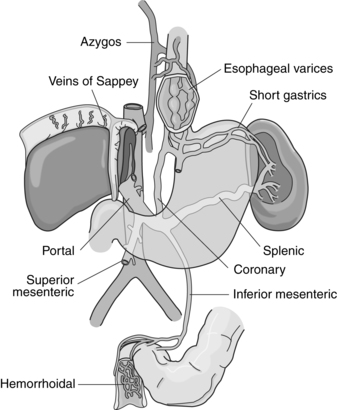70. Portal Hypertension
Definition
Portal hypertension is the presence within the portal circulation of a pressure gradient of 12 mm Hg or higher. This malady is associated with numerous conditions as listed in the box below.
Conditions Associated with Portal Hypertension
• Family history of hemochromatosis or Wilson’s disease (see p. 355)
• History of alcohol abuse
• History of blood transfusions and/or intravenous drug use (hepatitis B and/or C)
• History of jaundice
• Pruritus
Incidence
The frequency of occurrence of portal hypertension is not known.
Etiology
Development of portal hypertension can result from many causes, generally classified as prehepatic, intrahepatic (presinusoidal), intrahepatic (sinusoidal and/or postsinusoidal), and posthepatic.
Signs and Symptoms
• Altered sleep patterns
• Ascites
• Asterixis
• Clubbing of digits
• Distended abdominal wall veins (caput medusae)
• Dupuytren’s contracture
• Esophageal varices
• Gynecomastia
• Hematochezia
• Hepatic encephalopathy
• Hepatorenal syndrome
• Increased irritability
• Increasing abdominal girth
• Jaundice
• Lethargy
• Muscle wasting
• Palmar erythema
• Rectal varices
• Spider angiomas
• Splenomegaly
• Spontaneous bacterial peritonitis (SBP)
• Testicular atrophy
 |
| Portal Hypertension. Varices related to portal hypertension. Portal vein, its major tributaries, and the most important shunts (collateral veins) between the portal and caval systems. |
Causes of Portal Hypertension
Intrahepatic (Presinusoidal)
• Early schistosomiasis
Stay updated, free articles. Join our Telegram channel

Full access? Get Clinical Tree





